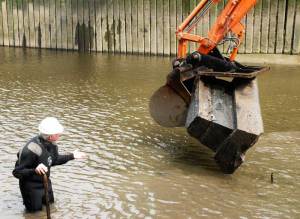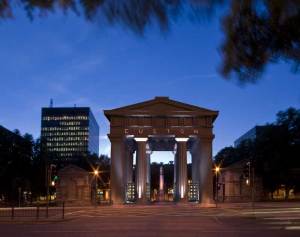The demolition of the Doric propylaeum – just to be pedantically correct – which stood in front of the first Euston Station, the greatest monument of the railway age, was an unforgiveable conservation crime: unforgivable because unnecessary. The ‘Arch’ could have been re-erected further south on the Euston Road, as the old London Midland & Scottish Railway accepted when it was planning to rebuild the terminus back in 1938. For some years now a movement to rebuild the Euston Arch has been growing, encouraged by the fact that in 1994 Dan Cruickshank discovered many of the original stones, if rather battered and damaged, dumped in a canal off the River Lea.
On 30 October the Euston Arch Trust held a public meeting – ‘The Euston Arch: The Next Steps’ – to keep the proposal alive. ‘We’re going to rebuild this! Now is the time to firm up the plans.’ Urgency, if not optimism, about this possibility is created by all the controversy about HS2 because, if the High Speed line is built, it will start at Euston. English Heritage and Camden Council both like the idea of rebuilding (or recreating?) the Arch on the Euston Road. Drawings and photographs exist to make an accurate reconstruction and some of the original stones could be reused.
The real problem, inevitably, is money. The cost of rebuilding the Arch is peanuts compared with the cost of rebuilding the whole station (let alone the cost of HS2), but already the Prime Minister is calling for economies in the scheme and the present proposals for a new station look depressingly utilitarian. All the more reason, perhaps, to give it some dignity by plonking a monumental Doric entrance gateway in front.

Dan Cruickshank with salvaged stone &credit; Euston Arch Trust
At the meeting, Dan Cruickshank discussed the history of the Arch and showed pictures of himself half submerged in the River Lea as fragments of Bramley Fall stone were hoisted out of the water. But perhaps more pertinent was the contribution from Philip Davies, who challenged the prejudice that it is somehow morally wrong to recreate buildings of the past. The same opposition, or prejudice, has emerged over the recent, extraordinary proposal to rebuild the Crystal Palace on the top of Sydenham Hill.
This prejudice comes from the modernist belief that we must only build in the ‘style of our day and age’. To do otherwise is an offence against the zeitgeist. It is a prejudice which ignores the fact that we no longer have a universally accepted architectural style – we live in an age of pluralism – and, besides, many ‘modern’ buildings today are really neo-modern as they revive and recycle forms and motifs from the past, from the 1920s.
Davies argued that it is perfectly acceptable to recreate buildings from the past when there are ‘valid cultural reasons’ for doing so – such as when significant monuments are destroyed in war. That is why the Cloth Hall at Ypres was rebuilt after it had been reduced to a pile of rubble during the First World War, why the historic centre of Warsaw was recreated after being wiped out during the Second World War. More recently, the destroyed Frauenkirche in Dresden has been painstakingly and lovingly rebuilt as a most beautiful symbol of peace and reconciliation, and the famous bridge at Mostar, broken during the civil war in the former Yugoslavia, has been rebuilt.

Rebuilt Arch by Night © Joe Robson, AVR London
Surely this is right. There are also precedents for rebuilding monuments on different sites, for, in London, neither the Marble Arch nor the Wellington Arch at Hyde Park Corner now stand where they were originally erected.
There can be no convincing moral argument against rebuilding one of the great British monuments of both the Greek revival and the railway age, and thus atoning for a great crime. The result would look magnificent, enhance Euston Station and be a tangible link with Britain’s heroic railway history. Such opportunities do not come very often: this one should be seized. Rebuild the Euston Arch!

Arch Enemies
The Euston Arch in 1938
Share
The demolition of the Doric propylaeum – just to be pedantically correct – which stood in front of the first Euston Station, the greatest monument of the railway age, was an unforgiveable conservation crime: unforgivable because unnecessary. The ‘Arch’ could have been re-erected further south on the Euston Road, as the old London Midland & Scottish Railway accepted when it was planning to rebuild the terminus back in 1938. For some years now a movement to rebuild the Euston Arch has been growing, encouraged by the fact that in 1994 Dan Cruickshank discovered many of the original stones, if rather battered and damaged, dumped in a canal off the River Lea.
On 30 October the Euston Arch Trust held a public meeting – ‘The Euston Arch: The Next Steps’ – to keep the proposal alive. ‘We’re going to rebuild this! Now is the time to firm up the plans.’ Urgency, if not optimism, about this possibility is created by all the controversy about HS2 because, if the High Speed line is built, it will start at Euston. English Heritage and Camden Council both like the idea of rebuilding (or recreating?) the Arch on the Euston Road. Drawings and photographs exist to make an accurate reconstruction and some of the original stones could be reused.
The real problem, inevitably, is money. The cost of rebuilding the Arch is peanuts compared with the cost of rebuilding the whole station (let alone the cost of HS2), but already the Prime Minister is calling for economies in the scheme and the present proposals for a new station look depressingly utilitarian. All the more reason, perhaps, to give it some dignity by plonking a monumental Doric entrance gateway in front.
Dan Cruickshank with salvaged stone &credit; Euston Arch Trust
At the meeting, Dan Cruickshank discussed the history of the Arch and showed pictures of himself half submerged in the River Lea as fragments of Bramley Fall stone were hoisted out of the water. But perhaps more pertinent was the contribution from Philip Davies, who challenged the prejudice that it is somehow morally wrong to recreate buildings of the past. The same opposition, or prejudice, has emerged over the recent, extraordinary proposal to rebuild the Crystal Palace on the top of Sydenham Hill.
This prejudice comes from the modernist belief that we must only build in the ‘style of our day and age’. To do otherwise is an offence against the zeitgeist. It is a prejudice which ignores the fact that we no longer have a universally accepted architectural style – we live in an age of pluralism – and, besides, many ‘modern’ buildings today are really neo-modern as they revive and recycle forms and motifs from the past, from the 1920s.
Davies argued that it is perfectly acceptable to recreate buildings from the past when there are ‘valid cultural reasons’ for doing so – such as when significant monuments are destroyed in war. That is why the Cloth Hall at Ypres was rebuilt after it had been reduced to a pile of rubble during the First World War, why the historic centre of Warsaw was recreated after being wiped out during the Second World War. More recently, the destroyed Frauenkirche in Dresden has been painstakingly and lovingly rebuilt as a most beautiful symbol of peace and reconciliation, and the famous bridge at Mostar, broken during the civil war in the former Yugoslavia, has been rebuilt.
Rebuilt Arch by Night © Joe Robson, AVR London
Surely this is right. There are also precedents for rebuilding monuments on different sites, for, in London, neither the Marble Arch nor the Wellington Arch at Hyde Park Corner now stand where they were originally erected.
There can be no convincing moral argument against rebuilding one of the great British monuments of both the Greek revival and the railway age, and thus atoning for a great crime. The result would look magnificent, enhance Euston Station and be a tangible link with Britain’s heroic railway history. Such opportunities do not come very often: this one should be seized. Rebuild the Euston Arch!
Unlimited access from just $16 every 3 months
Subscribe to get unlimited and exclusive access to the top art stories, interviews and exhibition reviews.
Share
Recommended for you
Better Out Than In?
What is the relationship between art and the market? And is an artist such as Banksy really better out than in?
Pastures New
Shoreditch’s EB&Flow gallery has changed its name to BERLONI and relocated to Fitzrovia, where the grass is literally greener…
Darkness Visible
‘Paul Klee: Making Visible’ at Tate Modern is rigorous but incurably serious – is it the right setting for such complex and colourful work?